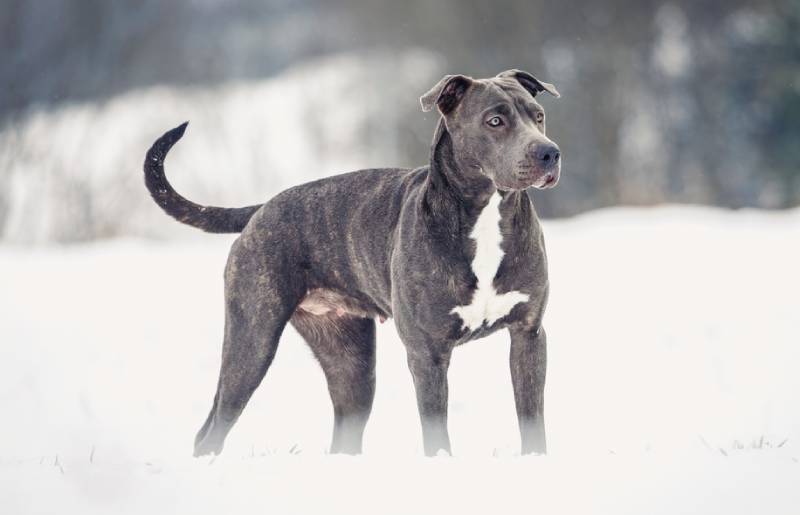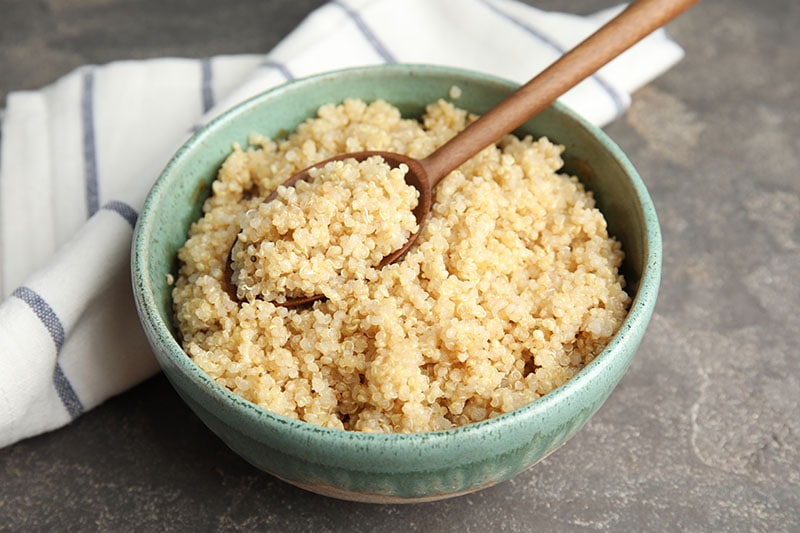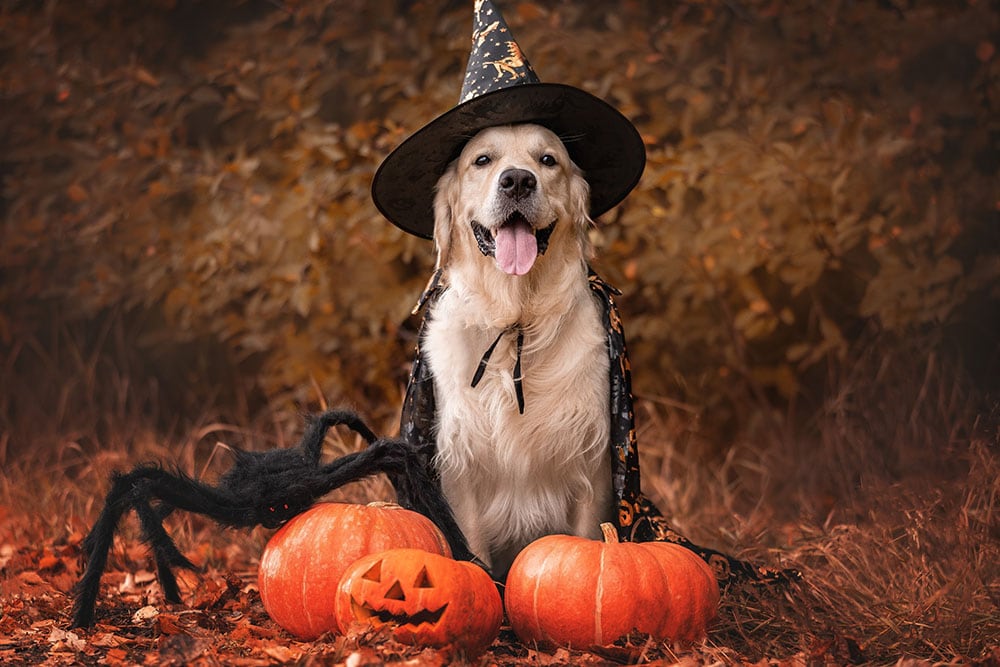Grey Pitbull: Facts, Pictures, Origin & History

Updated on

| Height: | 18–19 inches (male), 17–18 inches (female) |
| Weight: | 35–60 pounds (Male), 30–50 pounds (female) |
| Lifespan: | 8–15 years |
| Colors: | Grey, blue-grey, charcoal, and silver |
| Suitable for: | Are suitable as nanny dogs, unsuitable as apartment dogs |
| Temperament: | Eager to please, stubborn, moderately intelligent, independent, gentle, and loving, requires positive reinforcement training, gets along with other dogs but not smaller pets |
The Grey Pitbull is a specific breed coloring of the Pitbull Terrier. It is well known for its muscular and stocky body, intelligence, and sensitivity.
Depending on the parents they come from, Grey Pitbulls can feature a solid charcoal coat with white markings on their feet, chest, and tail. Basically, a Grey Pitbull exhibits some sort of blue or grey coloration on its coat.
Interestingly, this dog can be born with arresting bright blue eyes that slowly darken as it matures. Also, their faces are defined by sweet smiles. Read on this article to discover more facts and history of these dogs.
Pitbull Breed Characteristics
The Earliest Records of Grey Pitbull in History
The history of the Grey Pitbull may not be as detailed, but the two parent species have a very interesting history. Pitbulls come from a mix between a Bulldog and Terrier breeds, and grey is just one of the many colors that can be found in this breed.
Bull and Terrier breeds were originally developed in England in the 19th century for the sports of rattling and bull baiting. This can be attributed to the fact that they had a girthy frame, a wide head, and a lot of strength and vigilance.
However, the sports were outlawed in 1835, forcing sports enthusiasts to shift gears. Instead of using bulls, they started using rats, where they dug pits and placed the rats inside. The dogs were also trained to fight each other in these fight pits.
But since English Bulldogs were bred to fight bulls, they were too slow and big for the pits. This is one of the main reasons they were bred with English Terriers. The resulting dogs were more agile, tougher, and stronger. Thus, the Pitbull was born.
How the Grey Pitbull Gained Popularity
As earlier mentioned, American Pitbull Terriers were originally bred in England for bull baiting because of their courage, strength, and tenacity. However, when the sport was outlawed in the 1800s, the popularity significantly declined.
But when these dogs found their way into the United States, they warmed their way into the hearts of dog lovers. They were put to work on farms, protecting the owners from other animals and hunting wild game.
Although they became popular as companions instead of fighting dogs, their tenacity as fighters soon began to spread in the country.
In the early 1900s, the Pitbull became one of the most popular and desired dog breeds in America. Yet, their popularity began to decline in the mid-1900s, after reports of dog fights, among other aggressive behavior, surfaced in mainstream media.
Today, Pitbulls are some of the most controversial dog breeds in America. Some consider them affectionate and loyal family friends while others view them as dangerous animals. Fortunately, more and more people are changing their perspective of the Grey Pitbull and are now noticing their playful and loving nature.

Formal Recognition of Grey Pitbull
While Grey Pitbulls are recognized by several kennel clubs, it’s important to remember that of all the four distinct Pitbull breeds, some may be recognized by one kennel club and rejected by others.
The American Pitbull Terrier was recognized by the United Kennel Club (UKC) for the first time in 1898. This was after the dog was denied recognition by the American Kennel Club due to the fighting stigma surrounding the breed. Fortunately, Chauncy Bennet formed the UKC, specifically to register American Pitbull Terriers.
However, the club later expanded to include other dog breeds. Today, the UKC only recognizes the blue hue on the coats of the American Bully, the American Pitbull Terrier, and the Staffordshire Bull Terrier. The blue coloration also describes the grey coat color of the Grey Pitbull.
On the other hand, the American Kennel Club (AKC) admitted the Pitbull into its circles in 1930. Since then, AKC only recognizes the blue or grey coloring from the Staffordshire Bull Terrier and American Staffordshire Terrier.
Top 4 Unique Facts about Grey Pitbull
1. The Name “Pitbull” has an Unfortunate Provenance
The term Pitbull hails from a bloodthirsty and barbaric sport called rattling. This form of entertainment involved people throwing dogs and rats into a pit and putting a wager on which animal died the quickest. The “Pit” in Pitbull refers to the venue where the brutal sport was held.
2. Grey Pitbull Puppies Are Born with Wrinkled Foreheads
When Pitbull puppies start out, they feature wrinkles on their forehead. However, this physical trait slowly fades away as their foreheads grow smoother as they grow older. Science has never been able to explain this phenomenon up to this day.
3. Grey Pitbulls Do Not Have Locking Jaws
Many people assume that Grey Pitbulls have interlocking jaws. This can be attributed to the fact that when these dogs bite, they do not easily let go. However, it is not because the jaws are locked, but rather, they do not want to. Despite what the Internet and popular fiction might claim, no dog in the animal kingdom has interlocking jaws.
4. Grey Pitbulls May Have Aggressive Tendencies
Due to the unfortunate circumstances that brought Pitbulls into being, these dogs may have an innate urge to fight smaller animals and other dogs. They are prone to attacking animals, other dogs, and even people without provocation. Fortunately, a quick intervention by the owner can surprisingly calm the dog very easily, and it’s important to train and socialize Pitbulls to prevent potential aggressive behaviors.
Does a Grey Pitbull Make a Good Pet?
Despite the numerous myths, misconceptions, and unfavorable attitudes towards Grey Pitbulls, they can be great family companions and even better guard dogs. They are often regarded as aggressive dog breeds due to their muscular and stocky bodies, but keep in mind that their aggressive tendencies cannot be traced back to their genes. Instead, it’s brought on by their past experiences and their current relationship with the owner.
If properly trained, a Grey Pitbull can fill your home with love and you will end up with a family dog that is protective and loyal. They actually enjoy the company of people and can get quite attached to their owner. They also have sensitive souls and adore children so much that they can protect them with their lives. But again, they can get overly excited and become too boisterous with kids.
Nevertheless, ensure that your Grey Pitbull is socialized early on in life and that they are tamed enough not to show aggression or fear against other dogs. They require assertive but gentle training when they are puppies.
Overall, despite their bad reputation, Grey Pitbulls are ideal pets that you can keep at home.
In Conclusion
Grey Pitbulls are definitely a sight to behold. The hybrid blends all the best traits of the Greyhound and the American Pitbull Terrier to come up with an active, friendly, and fast dog. Grey Pitbulls may have different coat variations, but all of them are unique in their own way.
Before adopting one to join your household, you need to understand the various aspects of the dog to determine if the breed is an appropriate companion for your family members. While they may be amiable, to own one you need prior experience dealing with other dogs because they require some sort of expertise to handle them.
We hope that the information in this article will help you decide if the Grey Pitbull is ideal for your family.
Featured Image Credit: Annabell Gsoedl, Shutterstock













